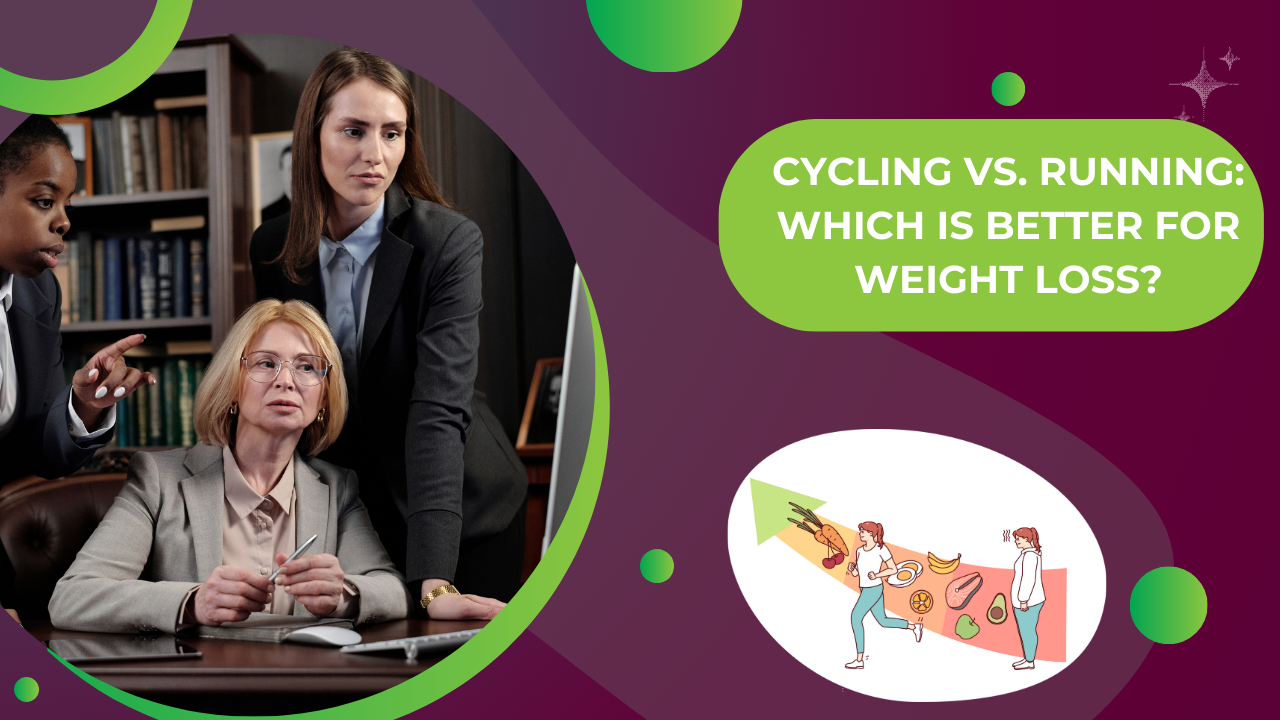Losing weight requires a combination of regular physical activity, a balanced diet, and consistency. Two of the most popular exercises for burning calories and shedding extra pounds are cycling and running. But which one is better for weight loss?
Both activities offer great cardiovascular benefits, help improve endurance, and aid in burning fat, but they also have distinct differences. Factors like calorie burn, impact on joints, muscle engagement, and sustainability all play a role in determining which exercise is best suited for weight loss.
In this detailed guide, we’ll explore the pros and cons of cycling and running, compare their effectiveness in burning calories, and help you decide which one fits best with your fitness goals.
Calorie Burn: Which Workout is More Effective?
1. Calories Burned per Hour

Calorie burn is one of the most important factors when choosing an exercise for weight loss. The more calories you burn, the faster you lose weight (when paired with a calorie deficit).
| Activity | Calories Burned (Moderate Intensity, 1 Hour) | Calories Burned (High Intensity, 1 Hour) |
|---|---|---|
| Running (6 mph) | 600-700 kcal | 850-1000 kcal |
| Cycling (12-14 mph) | 480-600 kcal | 750-900 kcal |
🏃 Running burns slightly more calories per hour than cycling, particularly at higher intensities. This is because running requires continuous full-body movement, while cycling allows brief moments of rest when coasting downhill.
However, cycling can still be highly effective for weight loss, especially when done at a high intensity or for longer durations.
2. Afterburn Effect (EPOC)
Afterburn, also known as Excess Post-Exercise Oxygen Consumption (EPOC), refers to the additional calories burned after a workout as the body recovers.
🏃 Running typically has a higher afterburn effect because it engages more muscle groups and requires more recovery energy.
🚴 Cycling can also trigger afterburn, particularly during high-intensity cycling (such as HIIT cycling or hill climbs).
Both exercises can help you burn calories even after you’ve finished working out, but running tends to create a slightly higher calorie deficit over time.
Impact on Joints and Injury Risk
1. Joint Impact: Which is Gentler on the Body?

🏃 Running is a high-impact exercise, which means it puts significant stress on the knees, ankles, and hips. Over time, this can increase the risk of injuries, particularly for overweight individuals or those with joint problems.
🚴 Cycling is low-impact, making it much gentler on the joints. Since your body weight is supported by the bike, cycling reduces the risk of joint strain and injuries.
2. Common Injuries in Running vs. Cycling
| Injury Type | Running | Cycling |
|---|---|---|
| Knee Pain | High Risk | Low Risk |
| Shin Splints | Common | Rare |
| Lower Back Pain | Moderate Risk | Moderate Risk |
| Overuse Injuries | High Risk | Low Risk |
🚴 If you have knee pain or joint issues, cycling is the better choice since it provides a great cardiovascular workout with less strain on the body.
Muscle Engagement and Strength Building
1. Which Muscles Are Used?
Both cycling and running target lower-body muscles, but they do so in different ways.
🏃 Running primarily works the following muscles:
- Quadriceps
- Hamstrings
- Calves
- Glutes
- Core muscles (for balance and stability)
🚴 Cycling engages similar muscles but adds more resistance:
- Quadriceps (especially during uphill rides)
- Hamstrings
- Glutes
- Calves
- Core and lower back
2. Does Muscle Growth Help with Weight Loss?
Building muscle helps increase your resting metabolic rate (RMR), meaning you burn more calories even when you’re not exercising.
Since cycling involves resistance training (especially uphill or in higher gears), it may help build more muscle in the legs and glutes compared to running.
However, running engages more overall muscles, including the core and upper body, making it beneficial for full-body conditioning.
🏆 Winner: Cycling for muscle growth, Running for full-body engagement.
Sustainability: Which Exercise is Easier to Stick To?
The most effective workout is one that you can stick with consistently.
1. Enjoyment and Variety
🚴 Cycling is often seen as more enjoyable because it allows you to travel longer distances, explore different routes, and even participate in group rides.
🏃 Running is simple and convenient, but it can become repetitive over time. Some people find it less exciting compared to cycling.
2. Accessibility and Cost
| Factor | Running | Cycling |
|---|---|---|
| Equipment Needed | Running shoes | Bicycle, helmet, gear |
| Cost | Low (just shoes) | Higher (bike, maintenance) |
| Space Required | Minimal | Roads or trails |
| Weather Dependence | Can run anywhere | Weather can be a barrier |
🏆 Winner: Running is more accessible and cost-effective, while cycling requires more gear and maintenance.
Mental Health Benefits and Motivation
1. Psychological Benefits
Both running and cycling release endorphins, the “feel-good” hormones that help reduce stress and improve mental health.
🏃 Running has been linked to a higher “runner’s high” due to its full-body impact and intensity.
🚴 Cycling is gentler and allows for longer, more relaxing rides, making it a great option for people who enjoy endurance-based workouts.
2. Social Engagement
- Cycling is often done in groups, making it more social and enjoyable.
- Running can be a solo activity or done in running clubs.
🏆 Winner: Cycling for social benefits, Running for mental clarity.
Best Workouts for Maximum Weight Loss
1. Running Workouts for Fat Loss
- Interval Running: Sprint for 30 seconds, walk for 1 minute (repeat 10 times).
- Hill Running: Burns more calories and strengthens muscles.
- Long Slow Runs: Helps build endurance and burn fat.
2. Cycling Workouts for Fat Loss
- HIIT Cycling: Alternate between high resistance sprints and low-resistance recovery.
- Hill Climbing: Engages more muscles and boosts calorie burn.
- Endurance Rides: Long-distance cycling improves stamina and fat metabolism.
Tip: Mixing both exercises can prevent boredom and improve overall fitness.
Final Verdict: Which is Better for Weight Loss?
| Factor | Winner |
|---|---|
| Calorie Burn | Running |
| Joint Health | Cycling |
| Muscle Building | Cycling |
| Accessibility | Running |
| Enjoyment & Variety | Cycling |
| Long-Term Sustainability | Tie |
Conclusion: Choose What Works for You
- If you want quick calorie burn and minimal equipment, running is a great choice.
- If you prefer low-impact, muscle-building workouts, cycling may be better.
- The best approach? Combine both for maximum benefits!
No matter which you choose, consistency is key. Stick with an exercise that fits your lifestyle and keeps you motivated.
🚴🏃 Which do you prefer—cycling or running? Let us know in the comments!
Readmore….https://totalinsights.online/wp-admin/post.php?post=28990&action=edit

